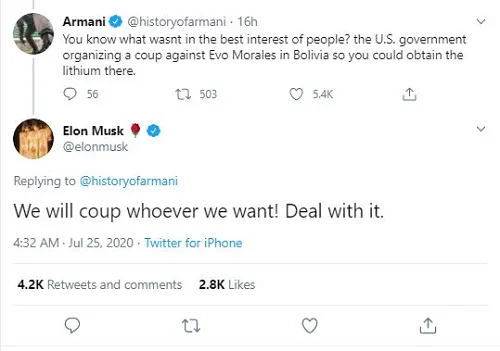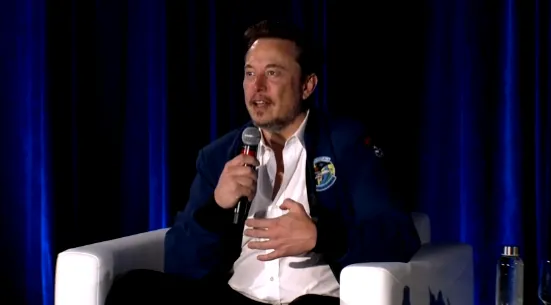Make no mistake, Elon Musk’s X project is a failure, and was on a solidifying path to bankruptcy, before Elon “saved” the platform by utilizing the political clout that he gained through the app to set his broader “X Corp” body of projects up for ongoing success.
Though the tactics that he’s used in doing so are highly questionable, and there’s still no guarantee that X will survive, long-term, as a general social media utility. And that’s before we get into his “everything app” expansion, but right now, X is indeed both solvent and safe due to a new injection of funding, as a result of Musk’s political wheeling and dealing.
Here’s a look at how Elon has used his government role to directly prop up his business, and the various conflicts of interest in such efforts.
And before we begin, to all the Elon fanboys reading this, yes, I am going to question his tactics, and no, you’re not going to agree with my audacity in daring to challenge the genius that is Elon Musk. I look forward to your emails and comments.
So, the narrative at this stage is that Elon Musk “rescued X from the brink”, through a series of shrewd strategic moves that have now made the platform relevant again.
Though that’s not entirely true, what Elon and his team have done is they’ve implemented a series of questionable strategies, while also weaponizing Musk’s newfound political influence, to halt the company’s slide into bankruptcy, which Elon himself has admitted was likely at one stage.
How? Well, to fully understand Musk’s evolving strategy at X, you have to go back to why he bought the app in the first place, and how he became enamored with the concept of Twitter as a political influence tool.
In the beginning…
The seeds of Elon’s Twitter purchase were planted back in 2019, when Musk and Tesla were seeking access to Bolivia’s lithium resources. Then Bolivian President Evo Morales was seen as a roadblock on this front, due to his commitment to maximizing broader market opportunities for the nation, while also protecting Bolivia’s natural resources.
With this as the backdrop, Morales was unseated in a coup in late 2019, and in the aftermath, reports suggested that the CIA helped to organize the revolution against Morales, which eventually led to Morales being replaced by Jeanine Áñez, who, shortly after her ascension, open the gates for U.S. companies to gain expanded access to Bolivia’s lithium (note: in 2022, Áñez was jailed for 10 years for her role in the U.S.-backed coup).
So how did the CIA supposedly influence a Bolivian political movement?
As reported by The Morning Star:
“Tens of thousands of fake Twitter accounts were created to support the military coup against Bolivia’s elected president Evo Morales, a new study suggests. Over 68,000 false accounts were set up to try to legitimize the army’s overthrow of Mr Morales following his re-election last month and to justify the massacres of protesters against the coup that have followed.”
The suggestion is that U.S. operatives essentially weaponized Twitter to fuel dissent, and drive the overthrow of the nation’s elected leader, in order to benefit U.S. businesses though expanded access to its resources.
And given his vested interest, Elon had a front row seat.

Musk quickly deleted this post, but this was the initial spark that seemingly opened his eyes to the broader potential of Twitter as both a political and market influence tool.
Throughout 2021, Musk became more active on Twitter, using his massive following to spark significant stock movements in various cryptocurrencies and businesses. These, seemingly, were experiments, of sorts, in seeing how Musk himself could sway sentiment and investor action, through his own tweets. Musk had also seen the impact of his tweets on the value of his own company, after posting comments about Tesla, which further underlined the value of the app as an influential force.
Like Donald Trump before him, Musk had learned that Twitter could be a powerful driver of action, and combined with his broader knowledge of how it had also been used to overthrow the Bolivian leadership, he solidified his plan to control that force for himself.
Taking stock
From 2021 onwards, Musk also began tentatively acquiring Twitter stock, with a view to how he might play a controlling role in its systems and policies moving forward. By April 2022, Musk had become Twitter’s largest shareholder, which preceded his move to acquire the company wholesale, which was finalized in late 2022.
Elon partnered with various investors, and took on a range of loans, in order to fund his Twitter purchase, with the mythology of his market genius underpinning the belief that he would be able to turn around its failing business.
Musk set to work quickly, culling 80% of Twitter staff, and shutting down regional offices, while also re-aligning its policies around political movements that he favors. That also aligned with the Republican party, and within that, Musk saw an opportunity to seize political power, by using Twitter as an influence machine on American voters.
The shift to Community Notes fact-checking and reduced moderation oversight both saved the company money, while also further aligning with this shift, and Musk then hitched his hopes to Donand Trump, and using his newfound influence to sway the American election, his most significant project.
And it worked. Donald Trump was re-elected, Elon Musk became a star of the Republican push, and he acquired a seat at the table at all of Trump’s cabinet meetings.
The cost, of course, is what Twitter itself lost advertising dollars, and public support, as Musk moves also allowed more and more misinformation and hate speech to proliferate in the app. The loss of ad dollars eventually threatened to kill the app entirely, with its revenues declining almost 50% on pre-Musk levels, and none of Elon’s grand plans to save it (like selling verification checkmarks) worked out like Elon hoped.
It’s safe to say that had Donald Trump not won the 2024 election, Twitter/X would’ve been on the ropes, amid accumulating debts and declining usage. Indeed, in October 2024, it looked certain that X was going to post a loss for the full year.
But by November, with Trump’s re-election secured, Elon’s strategic play was back on, and he emerged with a newfound swagger of political clout to force his will.
And force it he has, as a means to reinvigorate the flailing company.
Political foundations
So how is Elon looking to save X through his political influence?
Well, for one, following the election, X immediately set forth on a new push to pressure advertisers to re-up with the company, or face the potential wrath of Trump’s regulations.
As reported by The Wall Street Journal:
“With Musk ascendant after the election, X took a new approach to ginning up new ad spending. In December, a lawyer from X called a lawyer at advertising conglomerate Interpublic Group, hinting that its recently announced $13 billion deal to merge with rival Omnicom Group could face trouble from the Trump administration, given Musk’s powerful role. IPG signed a new annual deal with X for potential client spending.”
X has also used the threat of its ongoing lawsuit against the Global Alliance for Responsible Media (GARM) and its partners to pressure more big brands to resume their ad spend, prompting many to work out new deals to avoid the harms caused by a protracted legal battle.
But it’s Musk’s direct political integration, through his role with the Department of Government Efficiency (DOGE) that’s really going to solidify X moving forward.
In addition to his X project, Musk has also been pushing to become a player in the AI race, through his own AI project xAI. Musk seemingly came up with his xAI plan out of spite; Spurned by his rejection from OpenAI, after committing millions in funding in its initial stages, Musk has been incensed by the former non-profit company switching to a for-profit business model, from which Musk himself gains no benefit.
That’s the spark that prompted Musk to build his own AI project, to take on OpenAI, which he’s since framed as a “non-woke” alternative to the other, more censored AI projects.
And riding the broader AI hype, xAI has quickly become a relevant player, gathering billions in funding from various investors to fund its push into AI development.
Indeed, xAI is now reportedly worth $80 billion in its own right, which has now enabled it to absorb X, the platform, into its business structure.
Meaning that X now shares funding with xAI, and as such, its own financial performance is less important as a driver of its future. Given that X posts are a key data source for xAI, any funding that goes to Elon’s AI project is also now shared with X, which is how Elon has essentially “saved” X.
So is xAI actually worth $80 billion?
Well, it’s hard to say. OpenAI is reportedly forecasting more than $12 billion in revenue this year, based on subscriptions to its various AI generation models, including business and education packages designed to facilitate broader AI integration.
Presumably, xAI is aiming for the same market, though initial interest in its Grok AI chatbot has been limited based on X Premium take-up. But xAI launched a separate Grok app back in February, which it’s now pushing via Grok chatbot outputs on X, and the hope, seemingly, is that xAI will eventually raise money via rising consumer and business take-up. And with around half of Americans theoretically in favor of a less censored version of OpenAI’s offering, there should be a big market there.
But then again, it’s also facing competition from Google, Apple, and Meta, and it’s hard to see how xAI is really going to compete for that AI cash.
But xAI does have one major advantage that looks set to secure its future: Elon’s own political influence.
As Elon’s DOGE team has reported, the next stage of their government efficiency plan will involve the integration of AI into government systems, in order streamline operations, and further reduce costs.
You can bet that xAI will be a leading bidder on any tender for such a service, and with inside knowledge of the requirements for such, it seems that Elon’s AI play is set to win a range of major government supply contracts, and secure its funding into the future.
Which also seems like a conflict of interest, right? That a key government adviser shouldn’t be able to directly benefit his own companies in this way.
It seems like it, but that hasn’t stopped DOGE from also making X the central public communications platform for government agencies.
So Elon’s securing X’s future, by embedding it as an element of the U.S. government’s communications infrastructure, while he’s also on track to solidify xAI through government contracts.
Which is also how Starlink has succeeded, and SpaceX, using government funding to prop up Elon’s business empire, through long-term, self-securing deals.
So while Elon has, in theory, saved X as a platform, the framework underpinning this is political influence. Which is the exact reason why Elon originally purchased Twitter in the first place.
I mean, he intended to put pressure on politicians from a distance, by using the sway of X as a means to gain for favorable deals for his businesses. But now, he’s doing the same more directly, pulling the strings on government contracts to cement funding for his projects.
It’s an amazing feat, which few could pull off so blatantly, and in that sense, it’s hard to question the overall genius of Musk’s plan.
So I guess, in this sense, Elon is a galaxy brain leader, like he says, but the way he’s doing so is questionable, on many fronts, using the voting public as pawns for his own gain.
But that, again, has been the plan all along, with Elon using the influential value of Twitter/X for his own business gain.
If anyone questions the power of social media in the modern landscape, this is an amazing case study to consider.














